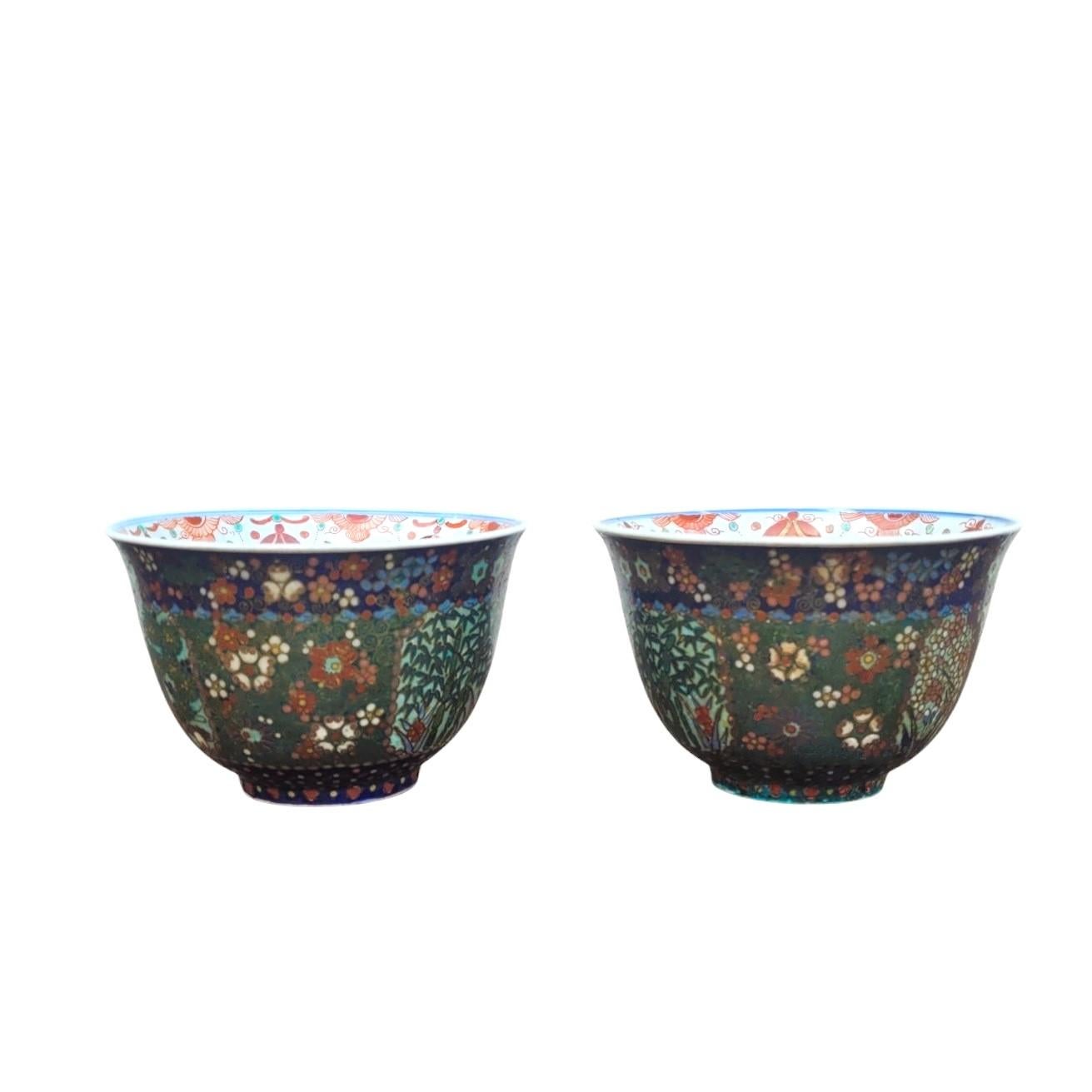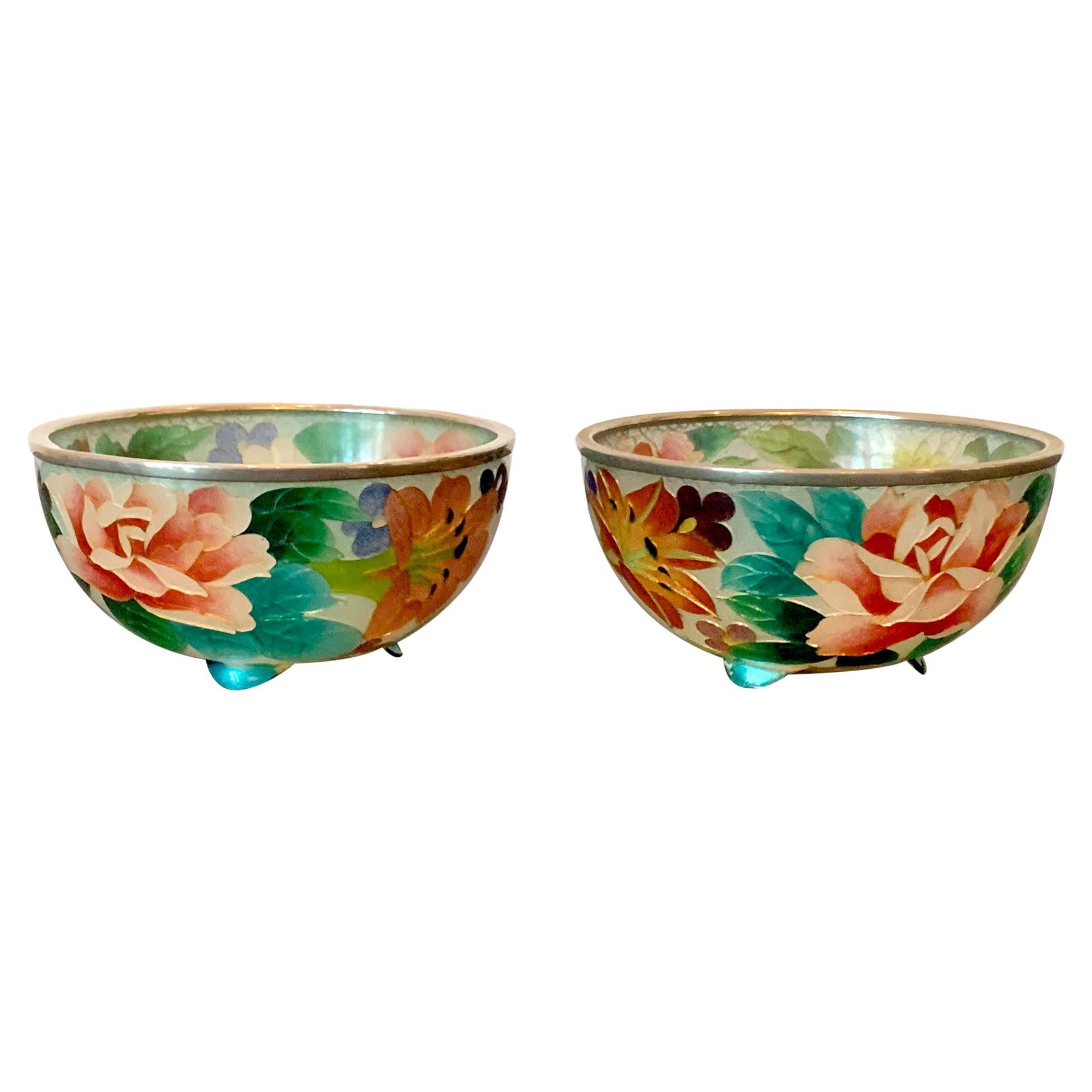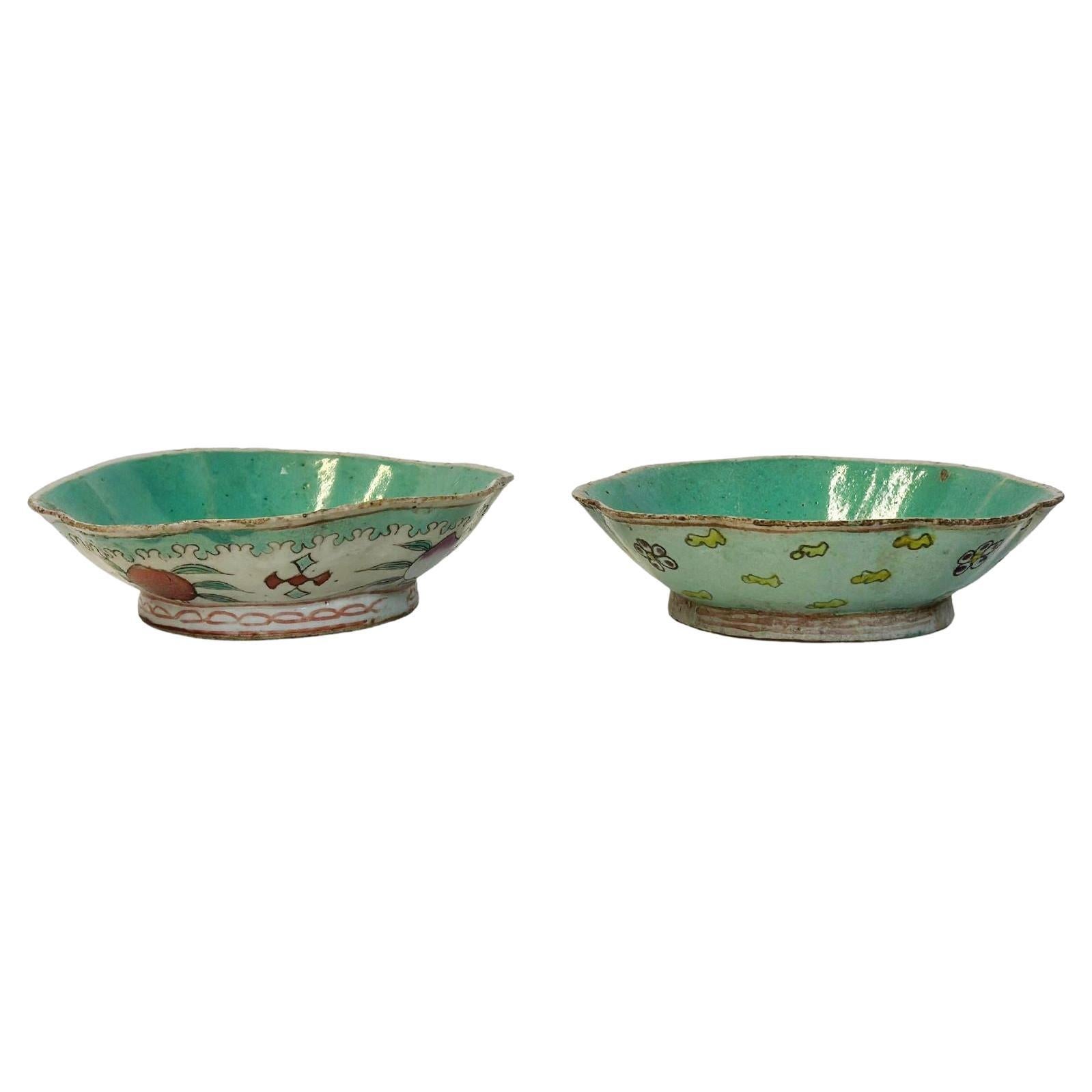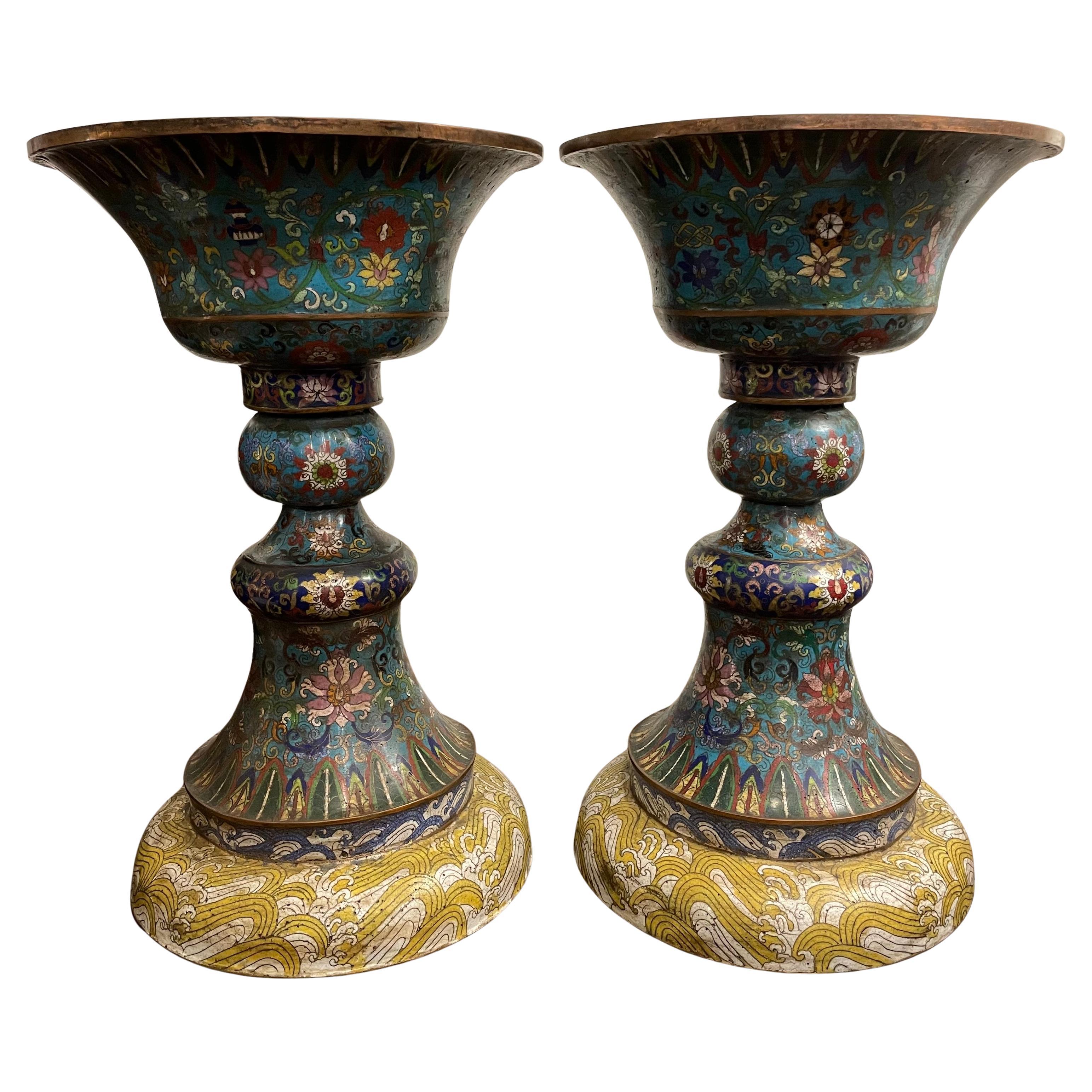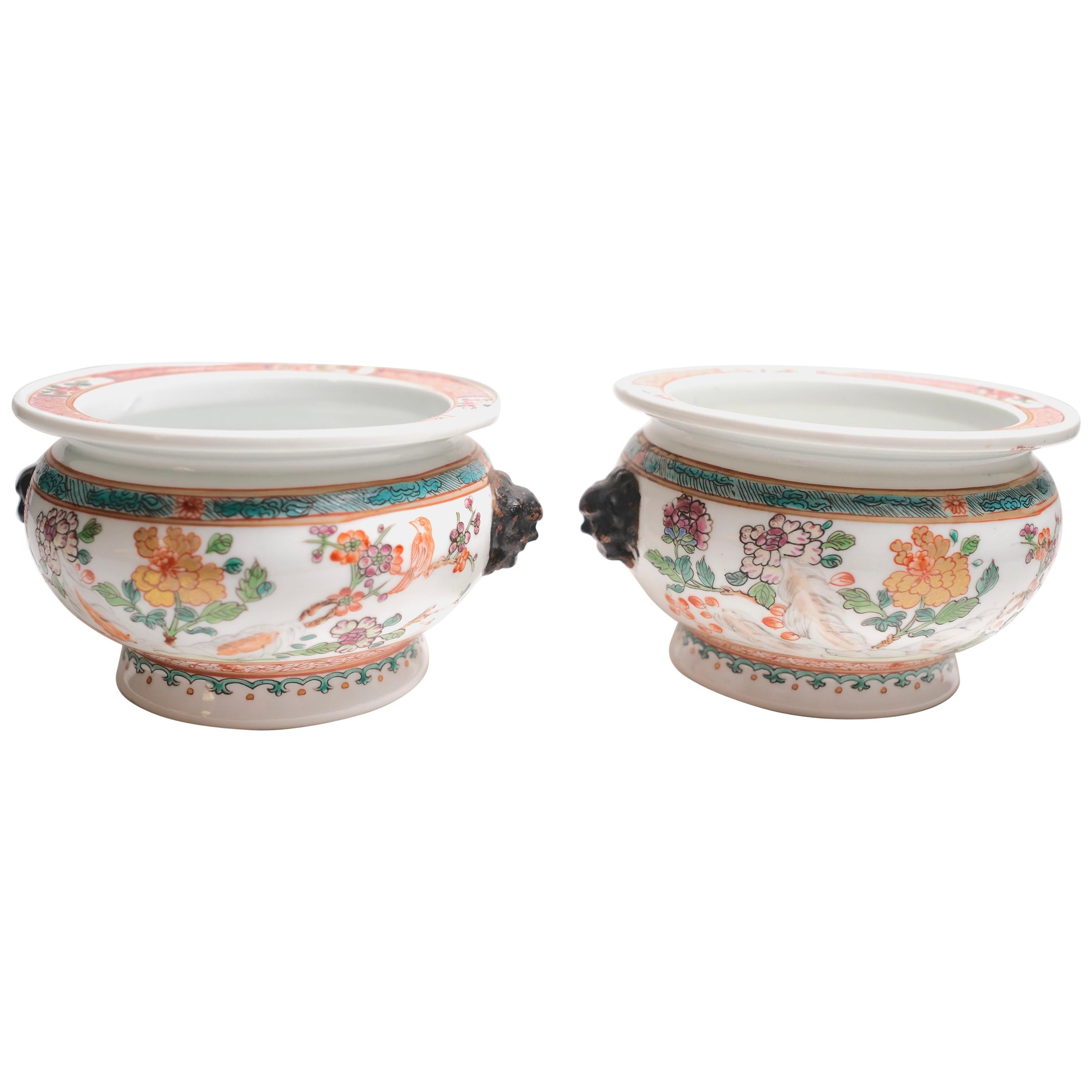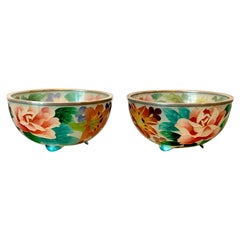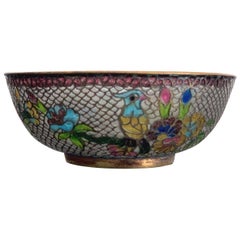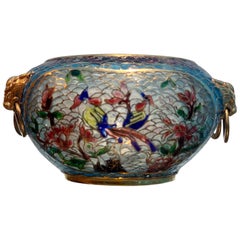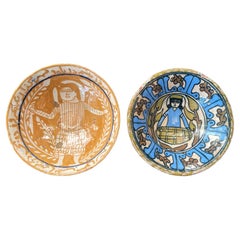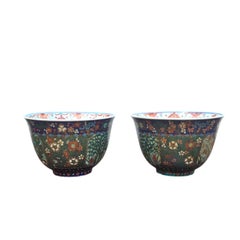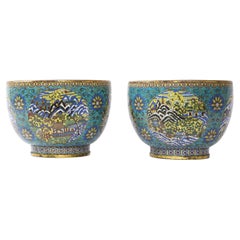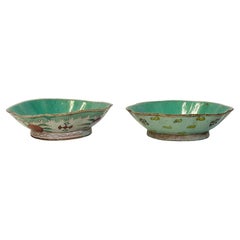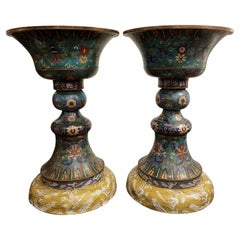Items Similar to Pair of Large Chinese Cloisonné Plique-à-Jour Bowls
Want more images or videos?
Request additional images or videos from the seller
1 of 13
Pair of Large Chinese Cloisonné Plique-à-Jour Bowls
$1,500
£1,146.83
€1,320.92
CA$2,101.96
A$2,346.64
CHF 1,229.60
MX$28,725.18
NOK 15,615.99
SEK 14,723.89
DKK 9,858.13
About the Item
A large pair of Chinese cloisonné enamel bowl made with the technique of plique-à-jour (means "letting in daylight" in French), a challenging method similar to small scale stained windows originally developed in the Byzantine Empire in 6th century AD. Using no backing and translucent enamel, it creates jewel-like piece.
This pair of bowl is of identical copper wire construction with a matching design. The main colors slightly differ with one in green the other blue. The copper based cloisonné cells feature large and small peony branches on a background of leave pattern. The miniature compartments "cells" were filled with enamels of different colors to precisely carry out the auspicious design while letting the light through. The design was also facilitated with many delicately pierced "cells" that further gives the pieces a very airy appearance.
- Dimensions:Height: 3.85 in (9.78 cm)Diameter: 8 in (20.32 cm)
- Style:Chinoiserie (Of the Period)
- Materials and Techniques:
- Place of Origin:
- Period:
- Date of Manufacture:1920s-1950s
- Condition:Wear consistent with age and use. No breakage or losses of enamel. Slight oxidation on metal wire and rims. One bowl may be slightly misshaped.
- Seller Location:Atlanta, GA
- Reference Number:1stDibs: LU945021742692
About the Seller
4.9
Platinum Seller
Premium sellers with a 4.7+ rating and 24-hour response times
Established in 2006
1stDibs seller since 2010
565 sales on 1stDibs
Typical response time: <1 hour
- ShippingRetrieving quote...Shipping from: Atlanta, GA
- Return Policy
Authenticity Guarantee
In the unlikely event there’s an issue with an item’s authenticity, contact us within 1 year for a full refund. DetailsMoney-Back Guarantee
If your item is not as described, is damaged in transit, or does not arrive, contact us within 7 days for a full refund. Details24-Hour Cancellation
You have a 24-hour grace period in which to reconsider your purchase, with no questions asked.Vetted Professional Sellers
Our world-class sellers must adhere to strict standards for service and quality, maintaining the integrity of our listings.Price-Match Guarantee
If you find that a seller listed the same item for a lower price elsewhere, we’ll match it.Trusted Global Delivery
Our best-in-class carrier network provides specialized shipping options worldwide, including custom delivery.More From This Seller
View AllPair of Early Japanese Plique-a-Jour Bowls from Nagoya
By Ando Jubei
Located in Atlanta, GA
A pair of small but exquisite Plique-a-jour cloisonné bowls with nearly identical design from Nagoya area in Japan circa 1900-20s. Maker's unknown but possibly by Ando company. The t...
Category
Early 20th Century Japanese Japonisme Metalwork
Materials
Metal, Enamel
Chinese Plique-a-Jour Bowl
Located in Atlanta, GA
A small Chinese cloisonne enamel bowl made with the technique of Plique-a-jour (means "letting in daylight" in French), a challenging method similar to small scale stained windows...
Category
20th Century Chinese Chinese Export Metalwork
Materials
Copper, Enamel
Chinese Plique-a-jour Archaic Style Bowl
Located in Atlanta, GA
A small Chinese cloisonné enamel bowl made with the technique of Plique-a-jour (means "letting in daylight" in French), a challenging method similar to small scale stained windows or...
Category
20th Century Chinese Chinese Export Metalwork
Materials
Copper, Enamel
Two Islamic Nishapur Glazed Pottery Bowls
Located in Atlanta, GA
A collection of two small pottery bowls with polychrome central figurative decorations, matching size and similar conical form. These bowls are identified as Nishapur ware circa 10th century (in nowadays Iran). They were stoneware (possibly buffware) and covered with opaque white glaze. Both were lovely decorated with a central human figure within an outer border. One is predominantly yellow, an imitation of luster ware...
Category
Antique 15th Century and Earlier Persian Islamic Ceramics
Materials
Ceramic
$3,600 / item
Rare Japanese Ceramic Glazed Bowl Makuzu Kozan Meiji Period
By Makuzu Kozan
Located in Atlanta, GA
On offer is a rare ceramic bowl with overglazed design by the famed Japanese ceramic artist Makuzu Kozan (1842-1916), circa 1906-1916. The bowl is rather unusual from the potter's repertoire with its unique glaze colors and decoration, and it likely belonged to a small series that Kozan made in and after 1906. A bowl of similar glaze and nearly identical dragon motif was recorded as a diplomatic present to the British royalty Arthur Connaught (1883-1932) when he represented King Gorge V in Japan in 1906. Other pieces, such as this bowl, were likely made with similar materials and designs afterwards.
Essentially round in form, the bowl has a generous volume with six harmonious lobes. The bottom of the interior showcases a coiled dragon in red, green and gold slithering on a cobalt blue background. The roundel shares an echoing lobed perimeter, which is further outlined by red and turquois bands and rising sun design. The exterior of the bowl features six stylized Japanese camellias...
Category
Antique Early 1900s Japanese Japonisme Ceramics
Materials
Ceramic
Pair Antique Japanese Artia Ceramic Cabinet Plates
By Arita
Located in Atlanta, GA
A pair of Japanese decorative ceramic plates, made in Arita for export market circa 17-18th century. The cabinet-display dishes feature lotus-petal gilt rim and a lavish tricolor ene...
Category
Antique 18th Century Japanese Japonisme Ceramics
Materials
Ceramic
You May Also Like
2 Cloisonné Bowls, Asia, Late 19th-early 20th Century
Located in MARSEILLE, FR
2 cloisonné bowls decorated with multicolored flowers and leaves.
The porcelain interior is decorated with blue and red flowers on a white background.
Wear and tear, a chip and ...
Category
Antique Late 19th Century Asian Chinoiserie Decorative Bowls
Materials
Porcelain
A Very Rare Pair Chinese Kangxi Period Cloisonné Planters w/ Landscape Scene
Located in New York, NY
An Extremely Rare Pair of Chinese Kangxi Period Cloisonné Planters with Landscape Scene. These vessels are formed in deep bowl shapes with recessed, gilt-lined rims and short, slight...
Category
Antique 18th Century Chinese Qing Metalwork
Materials
Bronze
Pair of Late 18th Century Chinese Famille Rose Bowls
Located in Los Angeles, CA
Traditional pair of Famille Rose bowls made in China in the Late 18th Century, decorated with fruit illustrations around each. They are made from fine enamel porcelain and also inclu...
Category
Antique Late 18th Century Chinese Decorative Bowls
Materials
Enamel
A Pair of Chinese Cloisonne Vases, Late 19th Century
Located in ARMADALE, VIC
A Pair of Chinese Cloisonne Vases, 19th Century
Provenance: Private Australian Collection.
Description:
Each on rolled foot with undulating standard rising to a tape...
Category
Antique Late 19th Century Chinese Qing Metalwork
Materials
Bronze
Pair of 19th Century Chinese Export Petite Bowls
Located in Los Angeles, CA
Hand painted, late 19th century.
Category
Antique Late 19th Century Chinese Chinese Export Decorative Bowls
Materials
Porcelain
$2,450 / set
Mirrored Pair of Chinese Cloisonne Lidded Bowls with Floral Motif
Located in San Diego, CA
A nice mirrored pair of Chinese cloisonne lidded bowls with floral motif, circa 1950s. The bowls are in very good condition with no dings or dents and measure 6.5"D x 3.5"H. #2606.
Category
Mid-20th Century Chinese Vases
Materials
Brass, Enamel
$600 Sale Price / set
20% Off
More Ways To Browse
6th Century
Chinese Cloisonne Enameled
Cloisonne Copper
Large Cloisonne
Chinese Bowl Small
Plique Jour
French Cloisonne
Blue Chinese Cloisonne
Chinese Green Bowl
Small Cloisonne
Chinese Enameled Bowl
French Enamel On Copper
Large Cloisonne Chinese
A Pair Of Chinese Cloisonne
Large Copper Bowl
Green Chinese Cloisonne
Vintage Blue Enamel Bowl
Cloisonne Bowl
